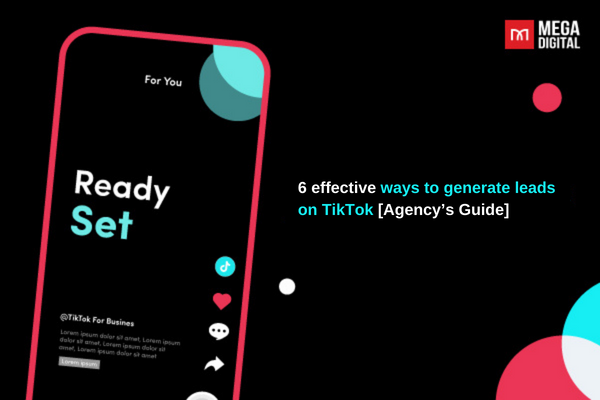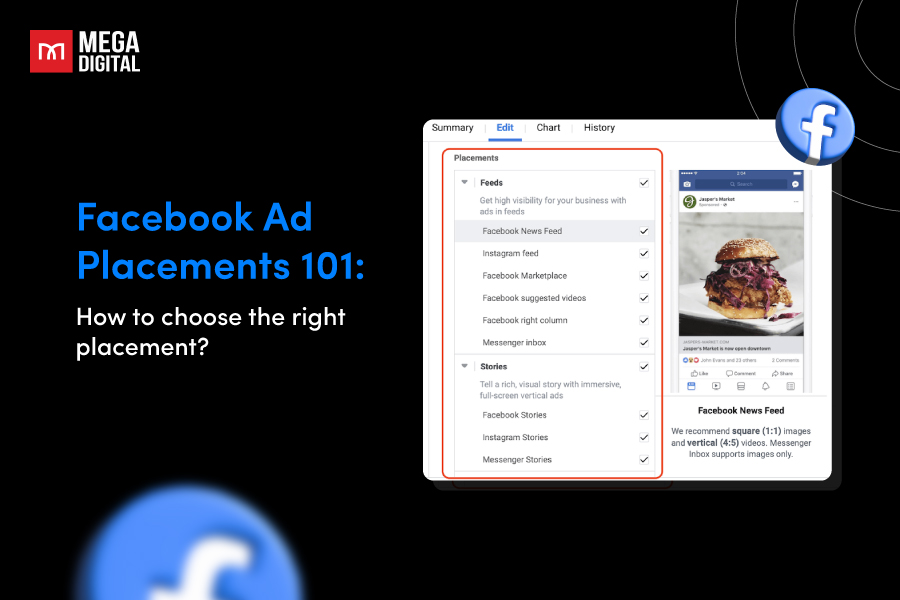A successful ad campaign does not only target the right customers and create high conversion but also needs to be budget-wise and achieve its goals with maximum efficiency. This means getting the most bang for your buck and ensuring every ad dollar is spent strategically. Here’s where Facebook bidding strategy comes into play. They’re the secret sauce to maximizing efficiency and ensuring every ad dollar you spend fuels campaign success.
So, do you want to know how? Get on with this article now!
What is Bid Strategy in Facebook Ads?
In Facebook advertising, bid strategy refers to the approach or method used to determine how much an advertiser is willing to pay for their ads to be shown or clicked on by their target audience. It involves setting the maximum amount that an advertiser is willing to bid for their ads to compete in auctions for ad placement.
Bid strategy choices impact various aspects of ad performance, including cost, reach, and targeting precision. Different bid strategies are available in Facebook Ads Manager, allowing advertisers to optimize their campaigns based on specific goals and objectives.
Benefits of Getting the Right Facebook Bidding Strategies
Imagine crafting the perfect Facebook ad: catchy headline, stunning visuals, and a call to action that compels action. You target the ideal audience, but something feels off – your campaign isn’t performing as expected. The culprit? An ineffective bidding strategy.
Here’s what an accurate Facebook bidding strategy could make to your campaigns:
- Budget Optimization: The right bid strategy ensures you’re not overspending. By aligning your bids with your goals and budget, you avoid unnecessary costs and maximize every advertising dollar.
- Reach the Right People: Different bids prioritize different results. Choosing the right strategy ensures your ads are shown to users most likely to convert, maximizing your return on investment (ROI).
- Boost Conversions: Bidding strategies go beyond impressions. By focusing on conversions (like website visits or purchases), you get your ad in front of users actively interested in your offer.
- Save Time & Effort: Automated bid strategies take the guesswork out of the equation. Facebook algorithms analyze user data and optimize bids in real-time, saving you valuable time and effort.
- Gain Valuable Insights: By analyzing results based on your chosen bid strategy, you gain valuable insights into user behavior and campaign performance. This knowledge allows you to refine your targeting options and future ad strategies for even greater effectiveness.
The right Facebook bidding strategy is the bridge between creating a great ad and achieving your advertising goals. It ensures your message reaches the right audience at the most efficient cost, turning your Facebook ads into a powerful tool for driving business growth.
How does Facebook Bidding Strategies Work?
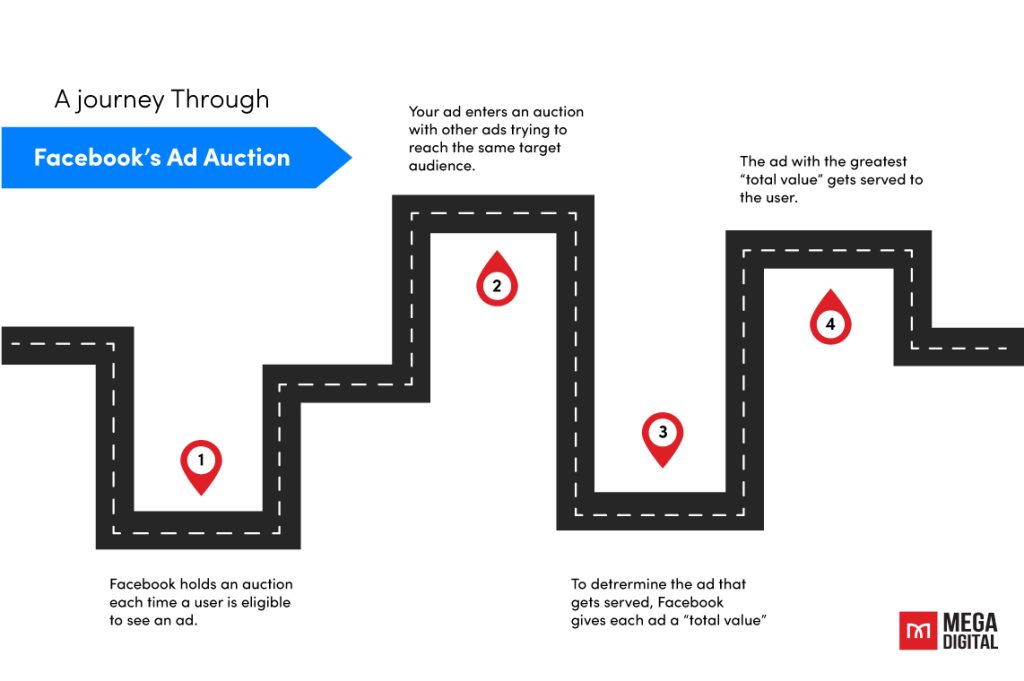
Imagine Facebook Ads Manager as a giant ad auction. Every time someone opens their feed, an auction is held in milliseconds to determine which ad will be displayed. Advertisers compete for these placements based on a combination of factors, including:
- Bid: The maximum amount you’re willing to pay for an action (impression, click, conversion)
- Estimated Action Rates: Facebook predicts how likely a user is to take your desired action after seeing your ad.
- Ad Relevance: How well your ad content aligns with the user’s interests and the platform (think high-quality visuals, clear messaging).
When you launch your ad campaign, Facebook uses your chosen bid strategy and your estimated action rates to determine the maximum bid it will place for each ad auction. The advertiser with the highest combined score (bid x estimated action rate x ad relevance) typically wins the auction and gets their ad displayed.
Facebook’s system continuously monitors campaign performance and adjusts bids in real-time based on your chosen strategy. You can track results within Facebook Ads Manager to see how your bids are performing and make adjustments as needed.
All Types of Facebook Bidding Strategies
Facebook Ads offers a variety of bidding strategies, each catering to different campaign goals and comfort levels with automated bidding. Here’s a breakdown of all the Facebook bidding strategies available to help you choose the right weapon for your advertising arsenal:
Automated Bidding
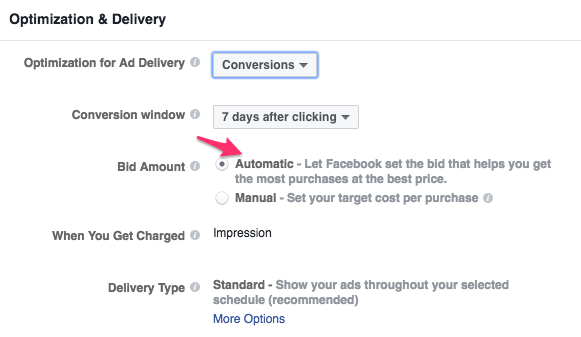
Automated bidding strategies take the guesswork out of campaign management, allowing Facebook’s algorithm to optimize your bids and stretch your budget further. Here’s a closer look at the three main automated bidding options on Facebook Ads:
Cost per Result (Cost Cap)
- Objective: Setting a price ceiling for acquiring a customer or desired action.
- Ideal for: Campaigns with clear goals and a defined budget. This strategy is your go-to for predictable costs and achieving a specific average cost per action (CPA), such as cost per click (CPC) or cost per purchase (CPP).
- How it works: Facebook takes the wheel, automatically adjusting your bids throughout the campaign to achieve your target cost. It analyzes various factors like user behavior, estimated action rates, and competition to find the sweet spot between cost and conversions within your budget constraints.
| Pros | Cons |
|---|---|
| Ensures you don’t overspend and keeps your campaign costs predictable | You relinquish some control over individual bids, but retain the ability to adjust your target cost as needed |
| Facebook’s algorithm handles the heavy lifting, saving you valuable time and effort | During the initial campaign learning phase, Facebook might not hit your target cost perfectly, but it optimizes over time as it gathers data |
| Prioritizes getting the most conversions possible at your target cost |
Highest Volume
- Objective: Spending your entire budget strategically to get the most impressions or clicks for brand exposure.
- Ideal For: Brand awareness campaigns or situations where maximizing reach or clicks within a set budget is the priority.
- How it Works: Facebook becomes your budget manager, allocating your daily or total budget throughout the campaign duration to maximize your chosen objective (impressions, clicks, etc.). It prioritizes placements likely to deliver the most results within your budget constraints.
| Pros | Cons |
|---|---|
| Easy to use, ideal for beginners who want a straightforward approach | Doesn’t directly optimize for conversions but can be used alongside conversion tracking for analysis |
| Stretches your budget to reach as many people as possible within your set limits | Focuses on maximizing reach, so engagement rates might be lower compared to conversion-focused strategies |
Highest Value
- Objective: Going all-in to acquire conversions quickly.
- Ideal For: Short-term, high-priority campaigns where immediate conversions are crucial, like limited-time promotions or app installs.
- How it Works: Facebook aggressively bids in auctions to get your ad in front of users most likely to convert, potentially driving up your costs per action (CPA).
| Pros | Cons |
|---|---|
| Prioritizes getting the most conversions (actions) possible within the campaign timeframe | Can lead to significantly higher costs per conversion compared to other strategies |
| Ideal for short bursts where immediate action is critical | May not be suitable for campaigns with tight budget constraints |
Manual Bidding
While automated bidding offers a convenient approach, some advertisers crave the ultimate control. Enter manual bidding on Facebook Ads – a strategy that puts you in the driver’s seat, allowing you to set specific bids for each ad auction.
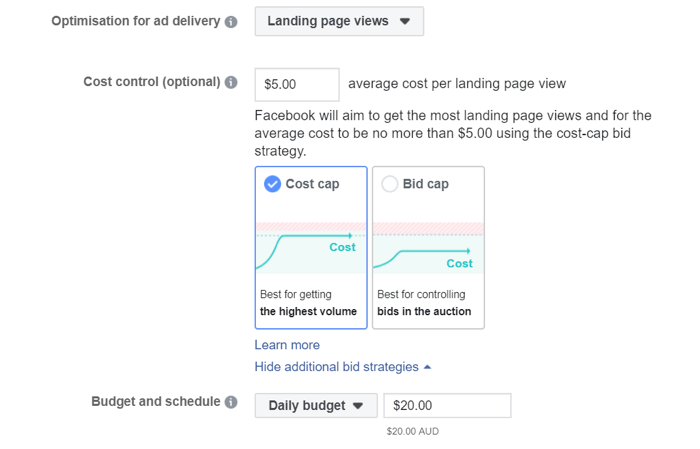
Cost per Result (Cost Cap)
- Objective: Setting a price limit for each ad auction.
- Focus: Set a maximum amount you’re willing to pay for each action (impression, click, conversion).
- How it Works: You determine the highest bid you’re willing to pay for each auction. Facebook will only bid that amount or lower to win the auction and show your ad.
| Pros | Cons |
|---|---|
| Offers the most control over your budget, allowing you to tailor bids based on factors like audience demographics, placements, and campaign goals | Not recommended for beginners, as it requires a deep understanding of Facebook Ads auctions, audience behavior, and competitor analysis |
| Ensures you don’t exceed your predetermined cost per action | Requires constant monitoring and bid adjustments for optimal performance |
Bid Cap
- Focus: Set a specific maximum bid for each individual ad auction.
- How it Works: You predetermine the absolute highest bid you’re willing to pay for each auction. Facebook will bid up to that amount to win the placement.
>>> Read more: Facebook Ads vs Twitter Ads – which platform is best to optimize your budget?
| Pros | Cons |
|---|---|
| Offers the most granular control over individual ad placements, ideal for highly specific campaigns | Demands constant monitoring and adjustments, making it extremely time-consuming |
| Easy to accidentally overspend if not managed meticulously |
How to Set Up Your Facebook Bidding Strategy
You can set up details of your ad campaigns, right in Facebook Ads Manager. Here’s a step-by-step guide to set up your Facebook bidding strategy for optimal campaign performance:
Step 1: Define Your Campaign Goals
What do you want to achieve with your Facebook ad campaign? Do you want to drive website traffic, generate leads, or boost sales? A clear understanding of your goals is crucial for choosing the most effective bidding strategy.
Step 2: Set Your Budget
Determine the total amount you’re willing to spend on your Facebook ad campaign. This will influence your bidding strategy selection and how aggressively you can compete in auctions.
Step 3: Choose Your Bidding Strategy
There are 2 types of bidding strategies Facebook offers to advertisers: Automated and Manual Bidding. You can select the option that best fits your background and business goal. It’s essential to evaluate any aspect of your business to determine whether you let Facebook handle your budget or take care of it on your own.
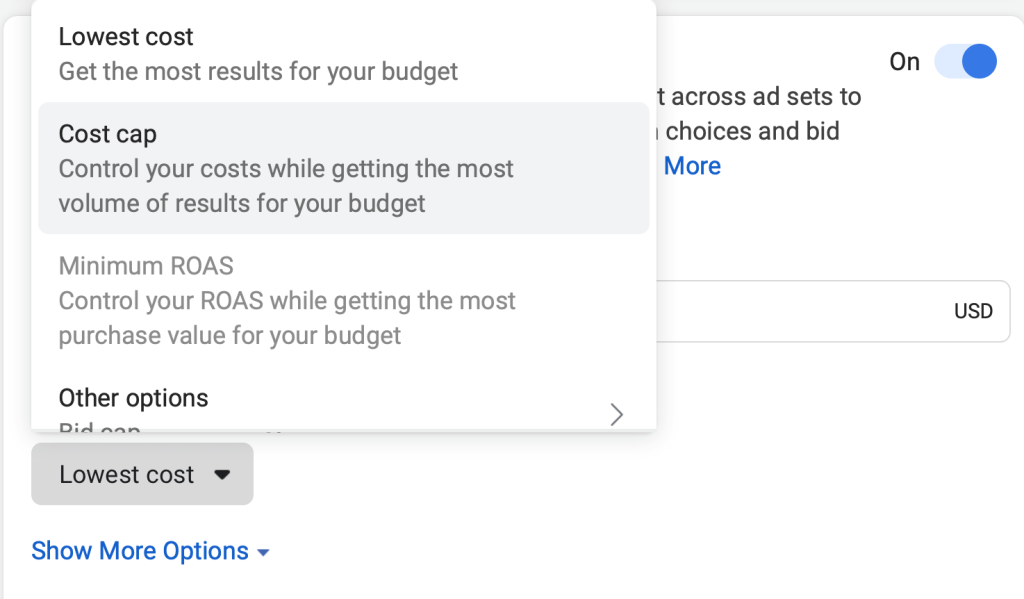
Which Facebook Bidding Strategy is Right for You?
Selecting the right Facebook bidding strategy is like choosing the perfect tool for the job. It depends on what you want to achieve and your level of comfort with campaign management.
Prioritizing Efficiency and Budget Control
Automated Bidding is your autopilot option. Facebook’s algorithm manages bids based on your goals and budget. Perfect for beginners or those who want a hands-off approach.
- Ideal for: Campaigns with clear goals and a defined budget.
- Best Options:
- Target Cost: Achieve a specific average cost for your desired action (e.g., cost per click or purchase).
- Maximum Budget: Get the most results possible within your daily or total budget (great for brand awareness).
Focus on Conversions (Actions)
If your campaign leans toward maximizing conversion, use the Automated Bidding strategy – Conversions will be more suitable. It prioritizes getting the most conversions possible, regardless of cost. Ideal for short-term campaigns where immediate action is crucial.
Complete Control over Budget
For experienced advertisers who crave precise control over every aspect and equires constant monitoring and adjustments, a manual bidding strategy would be the perfect choice.
- Ideal for:
- Niche audience targeting: Tailor bids to reach specific demographics or placements.
- Experienced users optimizing budgets: Allocate bids strategically across ad sets.
- A/B testing different strategies: Compare manual bidding performance against automated options.
Here’s a quick cheat sheet to get you started:
- New to Facebook Ads? Start with automated bidding (Target Cost or Maximum Budget) for a user-friendly experience. Or, start using a Facebook Ad Agency account and let experts handle the rest for you.
- Conversion Focused? Consider “Conversions” for short-term, high-priority campaigns, but be mindful of potentially higher costs.
- Experienced Advertiser? Explore manual bidding for ultimate control, but be prepared to invest time in management and analysis.
Note: The key is to experiment and track your results. Analyze which strategy delivers the best results for your specific goals and comfort level. Don’t be afraid to test and refine your approach to maximize the reach and effectiveness of your Facebook ad campaigns!
How to Optimize Your Facebook Ads Bidding Strategy?
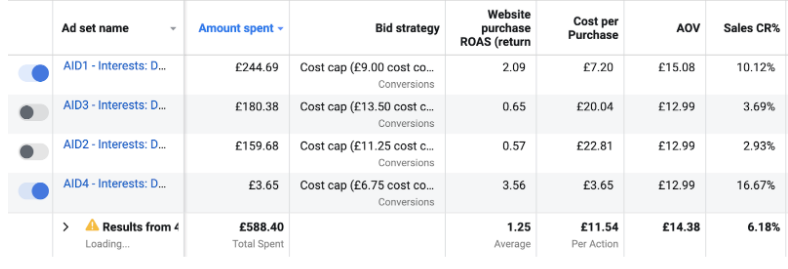
Choosing the right Facebook Ads bidding strategy is a crucial first step, but the journey doesn’t end there. To truly maximize your campaign performance, you need to optimize your bidding strategy based on data and insights continuously. I recommend some following best practices for advertisers and businesses to keep in mind when finetuning your bidding:
- Conversion Tracking: Make sure conversion tracking like Facebook Pixel or Conversion API is set up to measure actions like website visits, purchases, or sign-ups. This data is essential for evaluating your bidding strategy’s effectiveness in achieving campaign goals.
- Auction Insights: Utilize the “Auction Insights” tool for deeper analysis. It reveals how often your ads compete in auctions, win rates, and average bid ranks. This can help identify areas for improvement, like potentially raising bids for placements with high potential.
- Test Different Bidding Strategies: Don’t be afraid to experiment! Run A/B tests to compare the performance of different bidding strategies for your campaign. This lets you see which strategy delivers the best results for your goals and audience.
- Leverage Audience Insights:
- Facebook Ads Manager provides valuable insights into your target audience’s demographics and interests. Use this data to refine your targeting and potentially adjust your bidding strategy for specific audience segments. For example, you might consider higher bids for demographics with a higher conversion rate.
- Facebook Ad Library is also a perfect tool to take a sneak peek at what your competitors are doing. You can see which ad types they use and what they create for ad copy, like headlines, descriptions, CTA, etc.
- Lookalike Audiences: Utilize Lookalike Audiences to reach new users who share similar characteristics with your existing high-performing audience. This allows you to potentially optimize bids for a more targeted group with a higher chance of conversion.
- Automated Bidding Rules: If you’re using automated bidding strategies, consider setting up automated rules within Facebook Ads Manager. These rules can automatically adjust bids based on pre-defined parameters like budget pacing, conversion rates, or cost thresholds. This helps further optimize your bidding strategy without constant manual intervention.
The key takeaway is to optimize your bidding strategy based on your campaign goals and target audience. By using creative ad formats and avoiding overly broad targeting, you can decrease competition and achieve better results within your budget.
Wrap-up
By understanding the different options available, aligning your Facebook bidding strategy with your goals, and continuously monitoring performance, you can unlock the true potential of your Facebook ad campaigns. For advertising newbies, consider partnering with a trusted Facebook Agency, like Mega Digital, to make the most out of your buck and achieve your goals. So, if you’re still handling Facebook Ads alone, we’ve got you covered!







